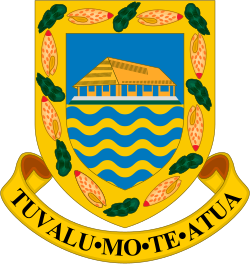| Coat of arms of Tuvalu | |
|---|---|
 | |
| Armiger | Charles III in Right of Tuvalu |
| Adopted | 1976 |
| Shield | Per fess Azure and Or in chief upon Grass issuant a representation of an Ellice Maneapa or meeting house all proper and in base four Barrulets wavy Azure a Brodure Or charged with Banana Leaves and Mitre Sea Shells placed alternately proper together[1] |
| Motto | Tuvalu mo te Atua "Tuvalu for the Almighty" |
The coat of arms of Tuvalu is a shield with a golden border, which is decorated in a pattern with eight mitre shells and eight banana leaves. The shield itself shows a maneapa beneath a blue sky on green grounds. Beneath the ground are stylised depictions in blue and gold of ocean waves. The coat of arms was approved by the College of Arms and granted by royal warrant on 3 December 1976.[1]
The motto is Tuvalu mo te Atua, Tuvaluan for "Tuvalu for the Almighty".[1] This additionally serves as the title of the Tuvaluan national anthem.
History
[edit]The coat of arms of Tuvalu featured on the national flag of Tuvalu in 1995-1996 but the design which was introduced in those years proved to be unpopular.
The old flag, featuring the British Union Flag in the canton and without the Tuvaluan coat of arms, was reinstated. The coat of arms is still featured on Tuvalu's state flag.
-
The colonial flag of Tuvalu, featuring the coat of arms
-
The 1995-1997 flag featured a slightly different coat of arms
-
The current state flag of Tuvalu
See also
[edit]References
[edit]- ^ a b c Laracy, Hugh, ed. (1983). Tuvalu: A History. University of the South Pacific/Government of Tuvalu.



Well, that’s interesting to know that Psilotum nudum are known as whisk ferns. Psilotum nudum is the commoner species of the two. While the P. flaccidum is a rare species and is found in the tropical islands. Both the species are usually epiphytic in habit and grow upon tree ferns. These species may also be terrestrial and grow in humus or in the crevices of the rocks.
View the detailed Guide of Psilotum nudum: Detailed Study Of Psilotum Nudum (Whisk Fern), Classification, Anatomy, Reproduction